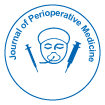
Journal of Perioperative Medicine
Open Access
ISSN: 2684-1290

ISSN: 2684-1290
Commentary Article - (2022)Volume 5, Issue 1
Infections are cause due to a variety of bacterial etiologic agents have become common and represent a large share of morbidity and mortality. On the other hand, the development of antibacterial drug resistance has been commonly reported worldwide. As a solution to these problems, scientific studies have to be conducted on traditional medicinal plants to develop, effective and safe antimicrobial drugs since plants are important sources. Traditionally, the study plant (Tinctoria A. Rich) has been used to treat fungal infections such as ring worms that cause tinea pedis and it also has different medicinal values. These were some of the provoking information to undertake the evaluation of antibacterial activities with its oral acute toxicity study. To evaluate the antibacterial activities and acute oral toxicity of aqueous, ethanol and ethyl acetate root extracts of impatiens tinctoria A. Rich.
Infectious diseases are the world’s leading cause of premature deaths, killing almost 13.4 million people per year. The World Health Organization (WHO) forecasts 13 million deaths attributed to this cause in 2005. Infections due to a variety of bacterial etiologic agents become common and are taking the big share of the burden [1]. Severe infections, including sepsis, meningitis and pneumonia are estimated to cause approximately one-third of the 2.6 million neonatal deaths globally, most of which are in less affluent regions of our planet. In Ethiopia, the top five leading causes of premature mortality in 2015 were lower respiratory infections, tuberculosis, diarrheal disease, ischemic, heart disease and human immunodeficiency virus/ acquired immune deficiency syndrome, which indicate the dominant fatality of infectious diseases.
There is also an alarming increase in the incidence of new and reemerging infectious diseases, some of which do not have drugs that act against them. For instance, over the past 40 years and a minimum of 50 emerging infectious agents have been identified across the globe; approximately 10% of them are bacterial agents [2]. Additionally, drug resistance has been commonly reported worldwide. For example, the development of resistance to methicillin has decreased the usefulness of this antibiotic in treating serious staphylococcal infections within the community and hospitalized patients. Presently, approximately 60,000 people in Europe and the United States die each year due to serious infections caused by antimicrobial-resistant bacteria. The problem is also high in Ethiopia, as indicated by few studies.
Despite such problems, medicinal plants have been used since ancient times to treat various diseases [3]. They are the basis for most traditional healing practices in which approximately 4.3 billion people of the world’s population use herbal medicines for some aspect of primary health care. Surveys carried out in developed countries such as Germany and Canada tend to show that no less than 70% of their population has used herbal remedies at least once, reaching 80% when we come to the emerging world. Traditional remedies are the most important and sometimes the only source of therapeutics for nearly 80% of the Ethiopian population and 95% of the preparations are of plant origin.
As a solution to these problems, scientific studies must be conducted on traditional medicinal plants to develop new effective and safe antimicrobial drugs. Locally, Ethiopian women chop or mash the inside of the roots of tinctoria A. Rich in to a paste to dye the palms and nails of the hands and feet as a beauty treatment to control fungal infections and to toughen the skin. The root decoction is also drunk against abdominal pains and as a purgative [4]. The stem is chewed to treat mouth and throat diseases. In view of this study aimed to scientifically justify the antimicrobial potential of this medicinal plant root extract against selected bacteria. The acute oral toxicity evaluation was necessary to identify the range and concentration of dose that could be used and the possible clinical signs elicited by this medicinal plant.
This metrics provides a scientific basis as the root of tinctoria A. Rich had promising antibacterial activity in an extract-dependent manner in which ethyl acetate extract showed better potency. Therefore, the antibacterial potential and practical nontoxicity of the study plant could take the attention of scientific communities for the development of new, effective and safe antimicrobial drugs by further studying the plant in different directions.
[Crossref] [Google Scholar] [pubmed]
[Crossref] [Google Scholar] [pubmed]
[Crossref] [Google Scholar] [pubmed]
[Crossref] [Google Scholar] [pubmed]
Citation: Degu S (2022) Evaluation of Antibacterial Activities and Metrics. J Perioper Med. 5:121.
Received: 12-Jan-2022, Manuscript No. JPME-21-12051; Editor assigned: 17-Jan-2022, Pre QC No. JPME-21-12051 (PQ); Reviewed: 26-Jan-2022, QC No. JPME-21-12051; Revised: 02-Feb-2022, Manuscript No. JPME-21-12051 (R); Published: 09-Feb-2022 , DOI: 10.35248/2684-1290.22.5.121
Copyright: © 2022 Degu S. This is an open-access article distributed under the terms of the Creative Commons Attribution License, which permits unrestricted use, distribution, and reproduction in any medium, provided the original author and source are credited.